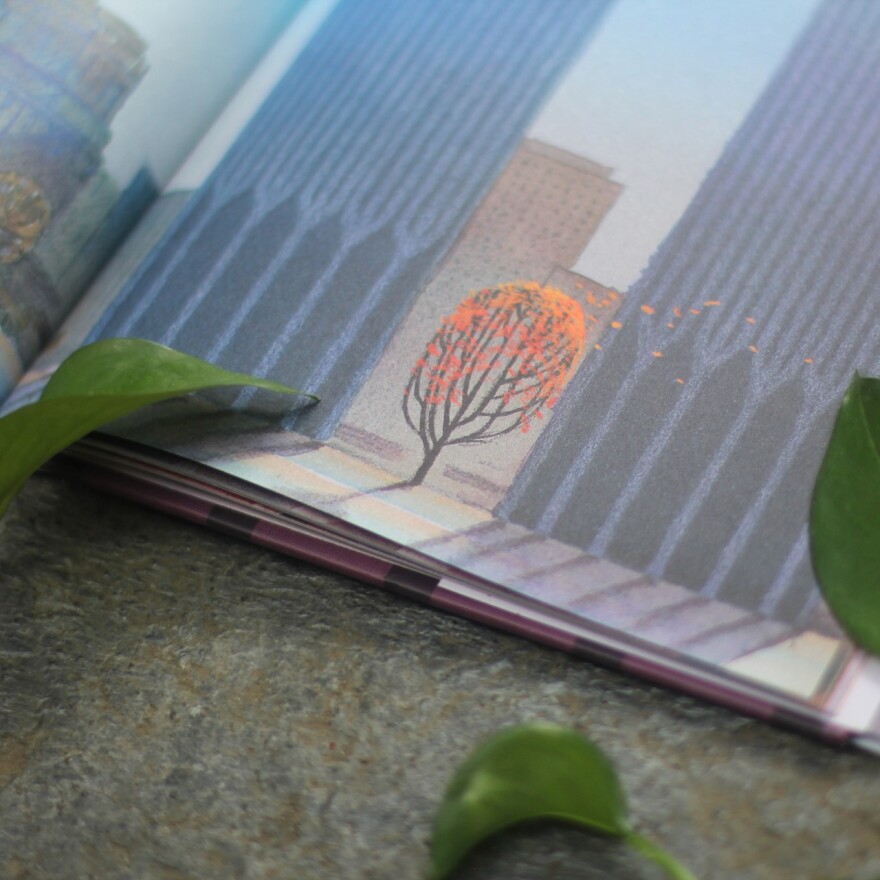"Survivor Tree" is a children's book written by Marcie Colleen and illustrator Aaron Becker of Amherst, Massachusetts. It tells the story of a growing pear tree found beneath the ruins of the Twin Towers. Today, the tree thrives and is planted at the 9/11 Memorial in New York.
Becker shares how the tree was discovered.
Aaron Becker, illustrator: The amazing thing about this tree is that they found it in the rubble in the fall, And the reason they found it was that it was sprouting spring leaves in October. And so this bright green leaf against the rubble was something that was quite visible and easy to see. And they pulled it out and had to trim the branches to make sure nothing else broke. And they brought it back to this nursery. And they didn't know, come the next spring, they didn't know if it would have survived.
Nirvani Williams, NEPM: I thought it was really interesting that the book starts and ends with the wind blowing around the leaves of all fall colors, but deep reds were specifically emphasized in the book. Why did you choose to highlight the color red in this way?
Aaron Becker, illustrator: The color red is a powerful color, and it's used when we want to get someone's attention. It also has connotations of warmth and love and maybe intensity, and all of those things belonged in this story. And so, on the cover, you see this tree sort of the red leaves blowing off of it in the fall, off into the distance, in an otherwise very kind of cool city-like landscape. And it just brings that extra level of warmth.
Nirvani Williams, NEPM: The story of 9/11 affected all New Yorkers and people all over the world in different ways. But your book shows how important it is to explain that event to younger generations. So I really wanted to know what was your process like figuring out how to depict grief in a children's book.
If there was ever a time for us to need to really look for hope where there doesn't seem to be any, it's now. It's a children's book, and I think that gives us permission to get close to it without feeling frightened as adults. And once an adult or even a child picks up this book, they're safe. You can get close and then you can access the grief in a way that's manageable and maybe even comforting.
The beautiful thing about this text that I had to work from was that it was open to interpretation. It was a lyrical, poetic text that looked into all of this grief and all of these feelings in this event, and it did so without mentioning our human experience of what happened. It did so through the lens of this tree, and this tree becomes this very childlike, innocent bystander to something atrocious.

So we get to move through the events of 9/11 without really having to see them. And I think that allows us to get close to our feelings of trauma, grief, mourning without being overwhelmed. And if we're overwhelmed, we shut down and we don't get close to a place where we can heal.
I noticed that death wasn't explicitly mentioned or explicitly depicted. And I just wanted to know if that was intentional or not, or what your thoughts were behind that.
What I've learned is that an image is completely open to interpretation. And so, it's my job as an illustrator to guide the viewer where I want them to go, but in a way that they get to discover it on their own terms and at their own pace.
So I'll do an illustration, for instance, of the billowing clouds right after the planes hit the towers. But you don't see the planes, you don't see the towers, you just see a blue sky and you see these billowing clouds. So it could be, really, a picture of clouds, of smoke, and not have all those connections. If you look more closely, you start to see that within these clouds, there are these little fragments of paper falling down from the towers and within those papers you see that there's photographs and within that photograph, you see that there's people that you may have seen earlier in the book.
But, again, if you're not ready to see that, you can just see the clouds. And if you're ready to turn the page because it's uncomfortable, just turn the page and it's gone. But if you're ready, it's all there for you. And I think throughout the story, that was my intention was to provide a safe place for this story that also had the opportunity to go deeper. And those details are there if you're ready to discover them.







